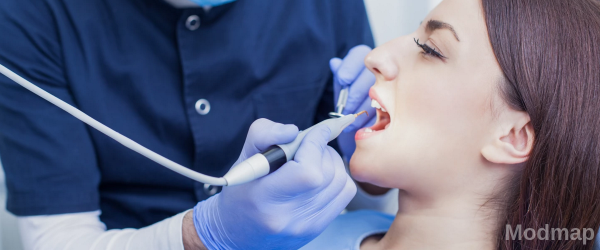
Oral care and timely diagnosis of diseases are key components for the health of the body. In this article, we will consider the main types of oral diseases, modern methods of their diagnosis, and also answer the most popular questions on this topic.
Main types of oral diseases
Caries
Caries is a destructive disease that affects the hard tissues of the tooth. It is characterized by the formation of cavities that can progress and lead to complications such as pulpitis or periodontitis.
Early diagnosis of caries is important for timely treatment and prevention of the development of serious complications.
Stomatitis
Stomatitis is an inflammatory disease of the oral mucosa. This term unites several forms of diseases that have different causes and are manifested by various symptoms.
Early diagnosis will allow prompt treatment and prevent the disease from becoming chronic.
Gingivitis and periodontitis
Gingivitis is an inflammatory disease that affects the gums. If the inflammation process spreads deeper, affecting the periodontium, a more serious disease develops – periodontitis.
Early diagnosis and treatment of these diseases can prevent tooth loss and maintain oral health.
Modern methods of diagnostics of diseases of the oral cavity
Visual examination and anamnesis
Visual examination and anamnesis collection are the first and main methods that a dentist uses during a consultation. They allow the doctor to assess the general condition of the oral cavity and identify the most likely problems.
But despite their importance, these methods are not the only ones. For more accurate diagnostics, doctors resort to more complex methods.
X-ray
Radiography plays a vital role in diagnosing periodontal, gum and dental diseases. It allows determining the stage of the disease and leads to the most correct treatment path.
Modern dentistry, including Apex dentistry, actively uses this method for scanning teeth and gums, thereby ensuring the accuracy of diagnosis.
Biochemical research
Biochemical analyses diagnose the state of the microflora and determine the presence of pathogenic microorganisms that cause inflammatory processes. They are necessary for more accurate determination of the cause of oral diseases and selection of an adequate treatment method.
Biochemical examination of saliva is an important step towards identifying possible disorders in the oral cavity, since the composition of saliva can indicate the presence of various diseases.
How to Properly Prepare for Diagnosis of Oral Diseases
Recommendations before visiting the dentist
Preparing for a visit to the dentist includes not only hygienic procedures for cleaning teeth and gums, but also proper nutrition, general health care, and some mental preparation.
On the day of your visit to the clinic, it is recommended that you refrain from eating and drinking 2-3 hours before the procedure, and do not smoke an hour before the appointment. It is also recommended that you prepare a list of questions that you would like to ask the doctor.
The Importance of Daily Oral Care
Daily care plays an important role in preparing for the diagnosis of oral diseases. Proper oral hygiene is the key to the health of your teeth and gums.
Try to brush your teeth twice a day, use dental floss to remove food from between your teeth, and change your toothbrush regularly. This approach, combined with regular dental checkups, will help you identify potential problems early.
Interpretation of diagnostic results of oral diseases
Understanding medical terminology
Understanding medical terminology is of great help in the process of conducting a dialogue with a doctor. Thus, you will understand exactly what certain terms mean and will be able to ask questions on the topic of your disease.
Learn basic medical terms related to oral health to better understand the process of diagnosing and treating diseases.4.2. What do the different stages of diseases mean?
Oral diseases have different stages that reflect the extent of the disease. Understanding these stages will help you make informed decisions about your treatment.
For example, early stage tooth decay may be treated by removing the diseased tissue and placing a filling, while advanced stages may require root canal treatment or even tooth extraction.
Conclusion
Oral diseases can negatively affect a person's quality of life and lead to serious complications. But timely diagnosis and proper treatment can minimize negative consequences and keep your smile healthy.
Don't forget to visit your dentist regularly, follow oral care recommendations, and be informed about the characteristics of various diseases and methods of their diagnosis.
Frequently asked questions
1. What symptoms indicate oral diseases?
Symptoms may include discomfort in the mouth, sensitive or painful teeth, bleeding gums, bad breath, discomfort or pain when swallowing, and changes in the color of the gums or lining of the mouth.
2. How often should you have dental checkups?
At least every six months. If you have a high risk of developing dental disease, you may need more frequent visits.
3. Will the doctor be able to determine the changes taking place if they are not visible visually?
Yes, your doctor may use a variety of diagnostic methods, including X-rays and biochemical tests, to detect diseases that are not visible to the naked eye.
4. Why is it necessary to conduct biochemical studies when diagnosing oral diseases?
Biochemical tests allow the doctor to determine the presence and activity of certain microorganisms, which can help in the diagnosis of various oral diseases, both less serious and more serious.
5. How can you find out if you have periodontitis?
The most common signs of periodontitis are bleeding gums, the presence of interdental spaces, and changes in the position of teeth. Only a dentist can accurately determine the presence or absence of the disease.





